Blue Catfish
Ictalurus furcatus
It's a strong fighter when caught on a fishing line
Advertisement
Blue Catfish Scientific Classification
- Kingdom
- Animalia
- Phylum
- Chordata
- Class
- Actinopterygii
- Order
- Siluriformes
- Family
- Ictaluridae
- Genus
- Ictalurus
- Scientific Name
- Ictalurus furcatus
Read our Complete Guide to Classification of Animals.
Blue Catfish Conservation Status
Blue Catfish Facts
- Prey
- Aquatic animals
- Group Behavior
- School
- Fun Fact
- It's a strong fighter when caught on a fishing line
- Estimated Population Size
- Unknown; 100 million in the Chesapeake Bay
- Biggest Threat
- None
- Most Distinctive Feature
- Large size
- Other Name(s)
- Blue channel, chucklehead cat, Mississippi cat, Fulton cat, forktail cat, great forktail cat, humpback blue, silver cat, and highfin blue
- Gestation Period
- 6-10 days
- Optimum pH Level
- 5.0-7.0
- Habitat
- Reservoirs, rivers, lakes, and ponds
- Predators
- Osprey, bald eagles, and humans
- Diet
- Omnivore
- Type
- Fish
- Common Name
- Blue catfish
- Number Of Species
- 1
View all of the Blue Catfish images!
The blue catfish is a ray-finned fish, a species of catfish, and the largest species of all North American catfish.
Although it is native to Mississippi river drainage, it has been introduced to several reservoirs, rivers, and lakes in other U.S. states. The largely freshwater fish can tolerate brackish water and a wide variety of climates. It is known for its long lifespan of up to 20 years, its large size and hardiness, having pest status in Virginia, and being good eating for humans.
5 Blue Catfish Facts
- It has a low mortality rate.
- Because it can tolerate brackish water, it has thrived in Virginia’s lakes, rivers, tributaries, and the Chesapeake Bay.
- People say its taste resembles that of rockfish.
- When it comes to finding food, its sensitive barbels are more important than sight.
- This catfish species is most often confused with the channel catfish.
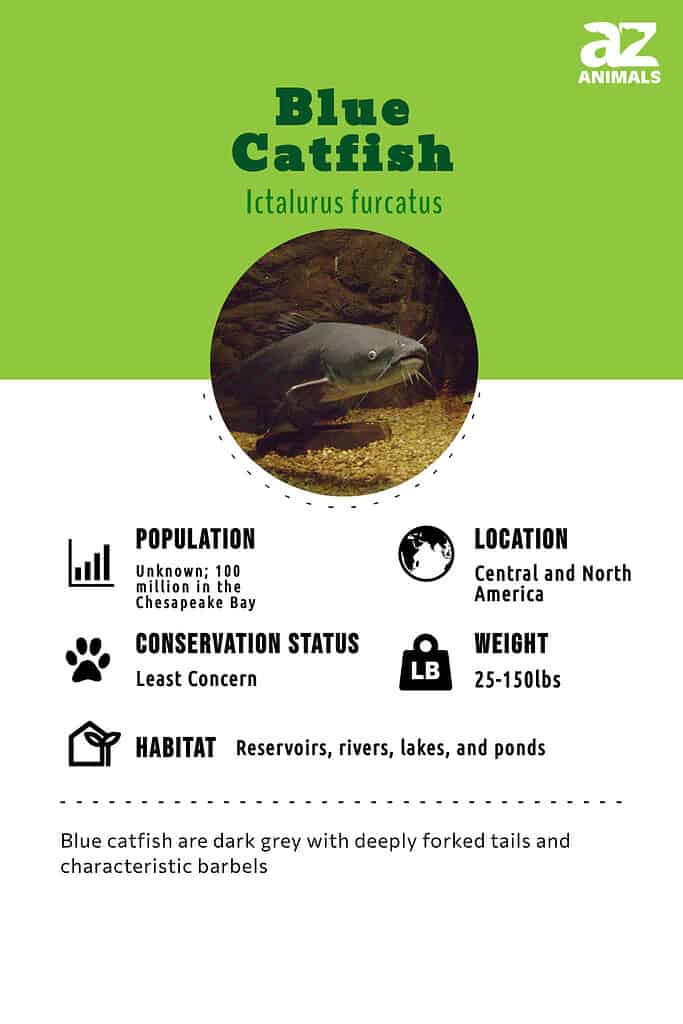
Classification and Scientific Name

Certain Blue Catfish may have dorsal fins which are taller than usual and known as high fin blues
©M Huston/Shutterstock.com
The blue catfish is in the class Actinopterygii of the ray-finned fishes and the order Siluriformes. It is in the catfish family Ictaluridae, which has 7 genera and 51 species. The species is also known as blue channel, chucklehead cat, Mississippi cat, Fulton cat, forktail cat, great forktail cat, humpback blue, silver cat, and high fin blue. Its scientific name is Ictalurus furcatus. Ictalurus is a description that means “fish cat” and furcatus means “forked” in Latin.
Some individual blue catfish have taller dorsal fins and are called high fin blues. However, such a variance is common and it doesn’t make them a separate species.
Appearance
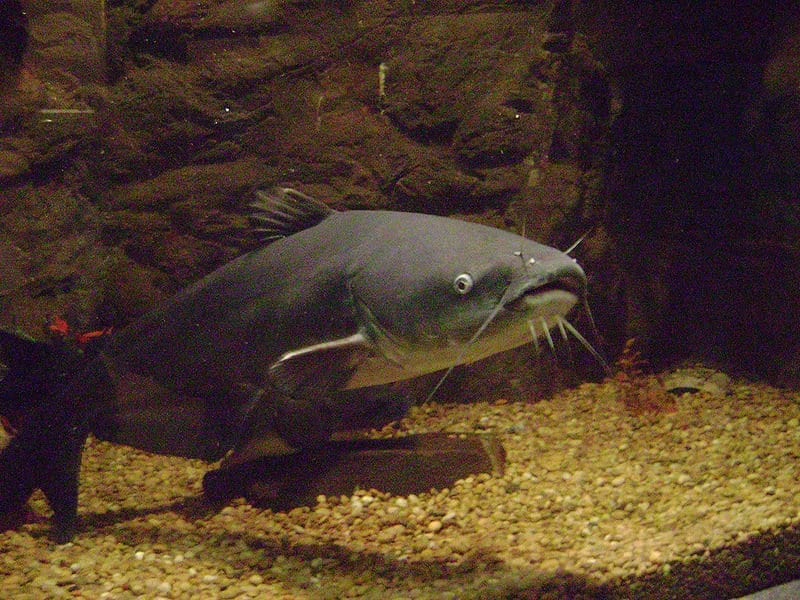
Blue Catfish often grow to over 100 lbs and are capable of reaching 150 lbs
Despite its name, the true color description of the blue catfish is not strictly blue. Many catfish species are a greyish color and this species is a silvery, dark grey-blue.
The blue catfish has a heavy body, silvery, deep blue-grey color, white belly, a dorsal hump, protruding upper jaw, a deeply forked tail, and barbels. The typical size of the blue catfish is 24-46in long and 25-40lbs. However, its size can reach up to 65 inches and 150 lbs in weight, and it is not uncommon for them to weigh more than 100 lbs. Males grow faster and reach larger sizes in both length and weight than females and their size diverges after 5 years. There have been several state records covering the heaviest and largest sizes of blue catfish catches:
- 143 lbs, 58in long and 47in around in the John Kerr Reservoir (Buggs Island Lake), Virginia–North Carolina border, and the world record as of 2011
- 136 lbs and 56in long in Lake Moultrie, South Carolina
- 130 lbs, 57in long and 45in around in the Missouri River
- 124 lbs in the Mississippi River
- 121.5 lbs in Lake Texoma, Texas
- 104 lbs in the Ohio River
- 120 lb blue catfish caught in Florida. This fish was caught in the Choctawhatchee river, but one caught in the same river at 69.5 lbs actually holds the state record, since it was caught by ‘rod and reel’ vs a trotline.
Blue catfish vs. channel catfish
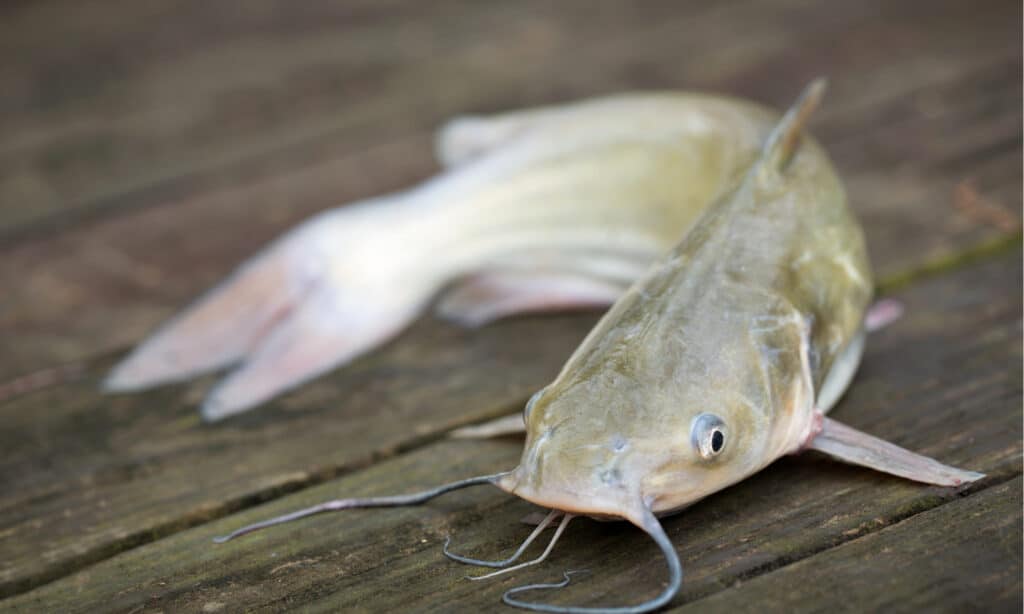
Unlike blue catfish whose anal fins have 30 – 36 rays, channel catfish have 25 – 19 rays
©Jennifer White Maxwell/Shutterstock.com
Due to similarities in the description of their appearance, this species is often confused with the channel catfish, with both being catfish in some overlapping habitats and having a somewhat similar color. The biggest difference between it and channel catfish is the number of rays on their anal fin. The blue catfish has 30-36 rays, whereas the channel catfish has 25-29 rays. Another difference is that the blue catfish is unspotted. Also, channel catfish are more numerous, and are the most numerous catfish in North America.
Evolution
Blue catfish belong to the second largest superorder of fish: the Ostariophysi. The creatures which eventually gave rise to the ostariophysians i.e., the members of this group made their way into freshwater during the Triassic period, about 251 million years ago.
A subgroup of the superorder known as the Otophysi which later on formed the Siluriformes which catfish belong to, emerged during the Jurassic period about 145 – 200 million years ago. This later event occurred before Pangea, the only existing continent on the earth had been broken up. The disintegration of the immense landmass gave rise to the division of the Otophysi into four distinct groups including the Siluriformes, or catfish which exist today.
Distribution, Population, and Habitat
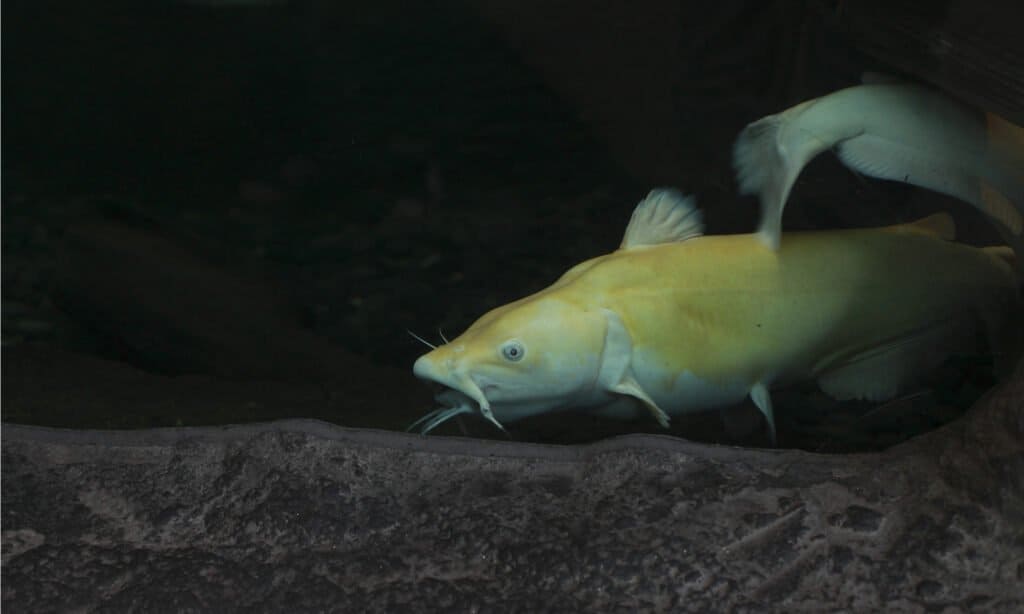
Blue Catfish prefer deep water with strong currents and a slightly acidic pH
©Brandy McKnight/Shutterstock.com
This fish can tolerate environments of brackish water and a variety of climates. However, its typical water environment is subtropical freshwater, and it lives in rivers, lakes, tributaries, and ponds. It is demersal, meaning it is a groundfish, with a depth range of at least 50m.
Its geographic distribution ranges from the USA with the Mississippi River basin from western Pennsylvania to southern South Dakota and Platte River in southwestern Nebraska, south to the Gulf and the Gulf Slope where it was introduced, Alabama and Florida, to Rio Grande drainage in Texas and New Mexico, Mexico, and northern Guatemala. It has also been introduced to Atlantic Slope drainages, Escambia river drainage, western states, Minnesota, South Carolina, Virginia, Illinois, and Florida. It is invasive to Chesapeake Bay and is native to the Missouri, Mississippi, Ohio, and Rio Grande river basins.
This fish’s favorite environment is the deep waters, channels, and impoundments of medium to large rivers where it dwells over mud, gravel, and sand. During the day, it stays on the bottom in the deeper areas and moves into faster-flowing water and near the surface at night to feed. It prefers strongly-flowing, clear water. Its optimal pH is 5.0-7.0, which is slightly acidic.
Its population is stable and listed as Least Concern according to the IUCN Redlist. Its number is estimated to be 100 million in the Chesapeake Bay, where it makes up 70% of the fish biomass.
Where to find blue catfish and how to catch it

Kentucky Lake and points below Kentucky and Barkley Lake dams are the best spots for catching Blue Catfish
©Cameron Sumner/Shutterstock.com
Below Kentucky and Barkley lake dams and in Kentucky Lake are the most popular places to catch this fish, but any large river where it lives will do. It migrates upstream during the summer to get to cooler temperatures. During the winter, they return downstream for warmer water. Common methods that are most effective for catching it are trotlines, set lines, rod-and-reel, limblines, and jugs. It will take any bait and is known for putting up a fight once it has taken the bait and gets hooked on a line. However, nightcrawlers, grasshoppers, minnows, cut bait, stink bait, chicken liver, cheese, hot dogs, and even bubble gum are all specific bait you can use. It is recommended to use a sponge hook with stink or dip bait.
Predators and Prey

Blue catfish are omnivores by nature and enjoy eating other fish. They constitute a threat to species such as herring and shad
©Four Oaks/Shutterstock.com
This fish has an omnivorous diet, eating both plant and animal matter. As a large predatory fish, it has a diverse diet of aquatic animals as its prey. Being an opportunistic predator as well as a bottom feeder, it also eats carrion or wounded prey. It has few natural predators. In the Chesapeake Bay, it threatens shad, herring, and blue crabs.
What does blue catfish eat?
Its prey are frogs, mussels, crayfish, small clams, mayfly larvae, dragonfly larvae, hellgrammites, other fish, and any other aquatic animals it can catch. Juveniles eat aquatic insects and smaller fish.
What eats blue catfish?
Osprey and bald eagles eat blue catfish. Humans also eat blue catfish as it is very tasty to many seafood lovers.
Reproduction and Lifespan
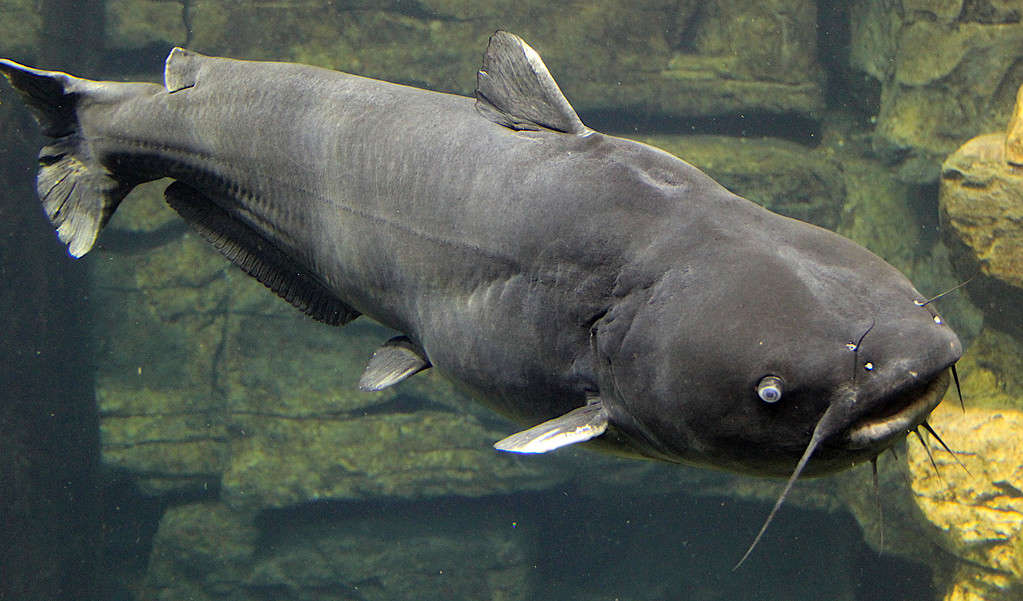
Male Blue Catfish grow larger and live longer than their female counterparts
©Thomsonmg2000, cropped and adjusted by Kostka Martin / CC0 – Original / License
This fish has an average lifespan of 9-10 years, although it can live up to 20 years and a maximum of 25 years, and there is a world record of 21 years. Males live longer than females and are the ones that set records and world records in size.
Females deposit their eggs in nests under brush, logs, or on riverbanks. Males build nests in backwaters and pools. This fish reproduces quickly, with females releasing 4,000-8,000 eggs per 2.2lbs (1kg) of body weight. Baby catfish, like other fish species, are called fry. Baby catfish, like other fish species, are also called juveniles, but that is usually when they have absorbed their yolk sacs. Once these fish have spawned, the males push the females away from the nests to organize and protect the eggs. The eggs hatch in 6-10 days. After hatching, baby catfish form close-knit schools and become independent within a few days. They become sexually mature once they reach 24in long.
Fishing and Cooking

Rockfish and blue catfish are believed to have similar flavors
©Besjunior/Shutterstock.com
This fish is caught in both recreational and commercial fishing. It is believed to taste like mud, but it does not and tastes different from the channel catfish. It is a delicacy with a delicious flavor similar to that of rockfish, and somewhat like striped bass. The description of its taste is too fishy if it has too much fat, which is why people tend to trim off the fat. It is typical to eat it in 4-6oz fillets. A high protein count of 19g, 1.5g of fat, and plenty of omega-3 fatty acids make it nutritious.
Some popular blue catfish recipes are:
View all 284 animals that start with BBlue Catfish FAQs (Frequently Asked Questions)
What is the best bait for blue catfish?
Any bait will work to catch blue catfish.
Are blue catfish good eating?
Yes, it is tasty and nutritious.
Are blue catfish poisonous?
No, they are not poisonous. It is a myth that their barbels sting.
Where are blue catfish found?
They are found in rivers, lakes, tributaries, and ponds in North America and even in northern Guatemala.
Can blue catfish live in ponds?
Yes, they can live in ponds and have been introduced to several ponds.
What do blue catfish eat?
Any aquatic creatures they can find, wounded or dead prey.
How big do blue catfish get?
They can grow to 24-65in long and weigh 40-150lbs.
Thank you for reading! Have some feedback for us? Contact the AZ Animals editorial team.


















